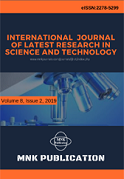DOI:10.29111/ijlrst ISRA Impact Factor:3.35, Peer-reviewed, Open-access Journal
Open Access
International Journal of Latest Research in Science and Technology Vol.9 Issue 3, pp 6-13,Year 2020
Correspondence should be addressed to :
Received : 25 June 2020; Accepted : 27 June 2020 ; Published : 30 June 2020

| Download | 127 |
|---|---|
| View | 194 |
| Article No. | 10994. |
Currently, scientists has been an urgency to develop vaccines against novel coronavirus, the COVID19 pandemic, coming from animals, effecting on the; global economy, education, civilization, professional and social life, and communities-health, travel and clinical-research. So, to tackle and overcome the situations, the “Barn Owl Breeding Project of Kanchannagar D.N. Das High School (HS)” where prevails an ecosystem complex with landscaping by trees, garden, play area, pond and river with agriculture; keeping and caring of Barn owl apparently acts as a keystone species in the food-chain-relationships. Rats that happen to spoil food items of mid-day meals, rooms, and documents are controlled by Barn owl. Bats of the banyan tree, make the school building dirty by their excreta are also controlled by this owl. Different pests and mongoose, which are found to significantly reduce food production in agriculture and pisciculture, are also appreciably kept in control. It is worth mentioning that the Barn owl plays the role of the top carnivore, predating on mongoose juveniles and bats, the carrier of coronavirus, showing the “Barn-Owl Act as a Social-Vaccine Against COVID-19 Improving Science and Technology-Communication-Environments-Agriculture-Biodiversity- Conservation-Socioeconomic-Applications with Joyful-Learning-School-Environment”. And, improves midday meal, arouses interest of students and communities on ecology-food-chain-relationships-issues, and contribute to sustainable-pisciculture-pond, agriculture, and kitchen-garden-management, micro- and macro- climate issues, and also community as well as students’ health and awareness development. They are also opening a path of more future research and communication, for the betterment of societal conditions benefitting global humanity by advancing innovations in the fields of scientific research.
Copyright © 2020 Subhas Chandra Datta et al. This is an open access article distributed under the Creative Commons Attribution 4.0 International (CC BY 4.0) license which permits unrestricted use, distribution, and reproduction in any medium, provided the original work is properly cited.
Subhas Chandra Datta , " Improved Science And Technology Communications: Barn Owl Act As Social Vaccine Against Covid-19 ", International Journal of Latest Research in Science and Technology . Vol. 9, Issue 3, pp 6-13 , 2020

MNK Publication was founded in 2012 to upholder revolutionary ideas that would advance the research and practice of business and management. Today, we comply with to advance fresh thinking in latest scientific fields where we think we can make a real difference and growth now also including medical and social care, education,management and engineering.

We offers several opportunities for partnership and tie-up with individual, corporate and organizational level. We are working on the open access platform. Editors, authors, readers, librarians and conference organizer can work together. We are giving open opportunities to all. Our team is always willing to work and collaborate to promote open access publication.

Our Journals provide one of the strongest International open access platform for research communities. Our conference proceeding services provide conference organizers a privileged platform for publishing extended conference papers as journal publications. It is deliberated to disseminate scientific research and to establish long term International collaborations and partnerships with academic communities and conference organizers.